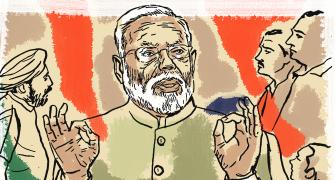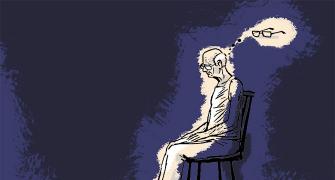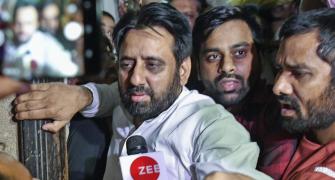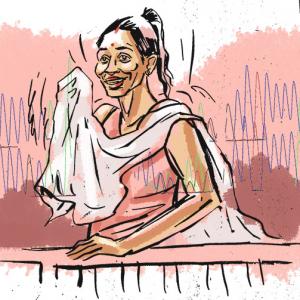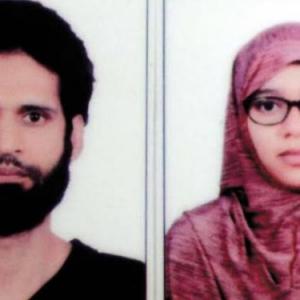When the hearings resume January 3, you wonder how many things will change and how many things will remain forever the same, as the Sheena Bora trial moves ahead.
Vaihayasi Pande Daniel reports from the final hearing this year in the sensational murder trial.
Illustration: Dominic Xavier/Rediff.com
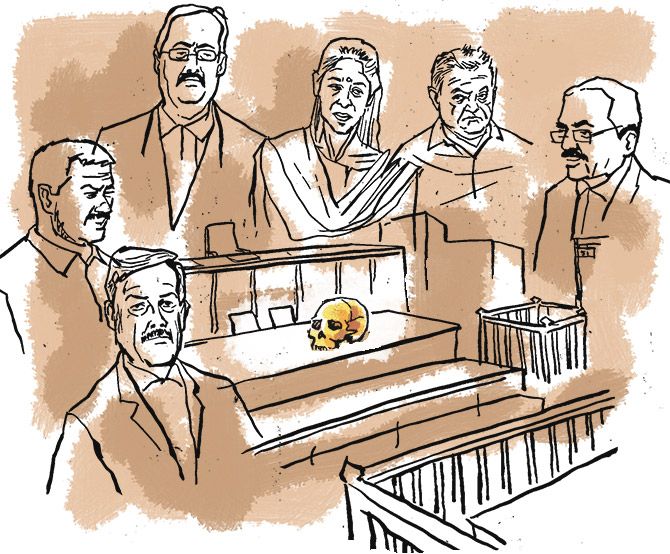
Another year -- unbelievably the third -- is coming to a close in the Sheena Bora murder trial.
We are now entering a new decade.
The last hearing of 2019 occurred on Tuesday, December 17.
The year 2019 saw some 36 witnesses come to the box in this unwieldy case, that chugs along at its own velocity. One of the relatives of the accused compared it to the gently flowing Ganga, for its lack of speed and its tortuous twists and turns.
This year we got to know, like old friends, in CBI Special Judge Jayendra Chandrasen Jagdale's Courtroom 51, at the Mumbai civil and sessions court, south Mumbai, several doctors and policemen, two travel agents, a tech tycoon, an actor, a Mukerjea colleague, a driver and many panchas*, among others.
Some were professionally quite sloppy.
Others much more competent.
Many were colourful people. Lively faces. Intelligent faces. Memorable faces.
Some seemed to lie barefaced.
Quite a few duds took the stand too. They were also hard to forget.
The most interesting witness of 2019, hands down, was forensic medical expert Dr Shailesh Chintaman Mohite, B Y L Nair Hospital, central Mumbai, for his crispness and professionalism.
Perhaps one of the more intriguing and critical has been Shrikant Hanumant Lade, the last witness of 2019, Prosecution Witness 59.
For the four accused, in jail since 2015, if and when they should ever get out of jail in this next decade, like victims of some time-warp, will be rubbing their eyes and looking at quite a Different India.
Courts teach you about law, crime, corruption, poverty, suffering, patience, justice, the lack of it. So much about life. And India.
Some of the greatest lessons of 2019 were:
- DNA evidence in a crime case is not sacrosanct.
- Many prisoners in overcrowded jails in India do not want bail or can't afford it.
- Even multiple bypass surgery required by an accused, doesn't call for medical bail for recovery, beyond the actual operation.
- Shoes are not allowed in jails.
- India, unlike many countries, has no forensic archaeologists/anthropologists, who use anthropology too, vitally, to isolate human remains, especially in legal situations.
- The Arthur road jail, central Mumbai, with a population pushing 3,800, has exactly one ambulance.
- Everyone needs to learn respect for the judicial system by visiting a court to see our judges at work.
- You won't value your life and freedom, the way you should, till you come to a court and see how tiny are the odds, always, of being deprived of them, sometimes, not so rarely, for no fault of yours, especially if you are poor.
On Tuesday, Lade's cross-examination came to an end after five days of hearings.
Lade, a forensic expert, who works in Kolhapur, once worked at the Forensic Science Laboratory, Kalina, north west Mumbai. Bones, teeth, soil samples from the site of discovery of a partially-decomposed/burnt remains of a corpse found in 2012 under a mango tree near in-the-sticks Gagode Khurd, Raigad district, excavated in 2015, were sent to Lade for DNA profiling.
It was Lade, through DNA analysis of the bones/samples from the site, who linked the remains to a DNA profile obtained from Indrani Mukerjea's blood sample.
His DNA fingerprinting work was like the magic key that unravelled this murder-mystery.
But was it a magic key? Or was the key manufactured to required specifications? Was Lade a wizard at his work? Had he unravelled the mystery?
Six hearings, including his testimony on November 19, nearly a month before, offered a slightly different spin on DNA experts and on how DNA analysis works and its limitations, failings and possible manipulations.
The three earlier days of cross-examination (earlier to Tuesday) revealed 1. That Lade's professional record had one if not two blots on it and that he was currently under suspension.
And 2. The five electropherograms**, put up as evidence by the prosecution, that are produced by the automated DNA sequencer machine, had, for some unfathomable, highly weird reason, some values filled in by hand. These were values that ordinarily should have been printed by the machine.
Lade could not provide any legitimate or sound reason, with proof, for having filled in values in his own handwriting.
Lade himself proved particularly intriguing because being the lynchpin of this case, he never acted like it, both strangely and to his credit. If he had been under pressure to hastily issue analysis and conclusions, he did not behave like an expert whose work, however rushed, was being questioned.
Instead, he was an emotionless and colourless man.
He could neither be roused to anger, pride, arrogance, irritation, frustration nor sadness or guilt.
Lade appeared like a kind of automaton, quite like the machines of his trade. Someone who had done his assignments and what was required of him like he had sleepwalked through it and as if there was no question of being emotionally invested in his work or profession.
There was nothing memorable about his manner of testifying or answering questions during the 'cross' either. They were drab, lifeless replies offered in often garbled language, that required a special ear to decipher.
Even under the most narrow, harrowing questioning by Indrani's lawyer Sudeep Ratnamberdutt Pasbola, his standard reactions were a slightly defensive "I cannot say" accompanied by an odd gestures of flexing of his shoulders and folding together of his hands, fingers interlocking. Nothing else.
So evidently he was a man of control, whose impassive, affectless face hid anything/everything about him. Was he numb? Stoic? Or simply passionless?
The other behaviour of note was the tendency to muscle his way through, like a steam engine and try to answer a question the way he wanted to, rather than the way Pasbola (whose giant steamroller skills are legendary) wanted him to.
As you can imagine, a few sparks flew. But they lead to minor, bloodless skirmishes, with no injuries. Like the time Pasbola bellowed, frustrated:
"Mr Lade please don't muddle the questions like you muddled your reports!" And Lade went meek.
Or when, as an answer to Pasbola's question, Lade tentatively asked if he could "volunteer' some information.
Pasbola boomed, livid: "Pahile answer kar! (first answer!). What volunteer-volunteer?!"
Or the moment when Pasbola and Lade wanted to speak at the same time. Both took off with desperate, impassioned:
"Pl-, pl-, pl-, pleeeeease, Mr Lade!"
And "Pl-, pl-, pl-, pleeeeease, sir!"
The only additional interesting bit was, that like his predecessor in the witness box Dr Mohite, Lade had great spelling skills and often offered the spelling of medical and non-medical terms, impeccably, to the rather efficient young court stenographer, Vaibhav.
Tuesday, wearing a bright blue shirt, black trousers, grey sports shoes and carrying a plastic bag that had Dulhan emblazoned on it, Lade entered the witness box for the last time at about 11.40.
On the fifth day (as well as the fourth) of Lade's cross-examination Pasbola focused on three other important aspects of Lade's efforts to analyse the DNA related to this case and crime.
~Firstly, Lade, who was already suffering under a backlog of 30,000 cases post the massive testing required after the beef ban, had been under pressure from his boss Balasaheb B Daundkar, head of the FSL and the Khar police station, north west Mumbai, who were handling the case initially, to provide speedy results for a whole range of DNA extraction tests. He delivered them in a week.
Lade denied any backlog in spite of being shown press reports where he spoke about the backlog (he denied speaking to the press too) and how his lab had worked extra hours and in a compressed time delivered results in the Sheena Bora case.
Pasbola also produced a letter dated September 7, 2015 from a Mahesh Kanekar, Khar police, asking for the results to be expedited.
~Secondly, Lade had not felt the need to analyse Sheena's father, Siddhartha Das's DNA for some inexplicable reason.
Pasbola: "Do you know why the blood of the father was not made available?"
Lade: "No."
Pasbola: "Can you elaborate the importance of having the blood of both parents?"
Lade: "To detect paternity you require the DNA profile of mother, child and the father. To detect maternity you require only the DNA profile of mother and child."
Pasbola: "What is the advantage of getting the DNA profile of father and mother"
Lade's answers initially lacked substance.
Pasbola got exasperated and appealed to the judge: "But he is the expert!"
Judge Jagdale replied astutely, laughing wholeheartedly, "Tumhi jaashti expert! (You are the bigger expert!)"
Finally, Lade: "The advantage is that we get the perfect biological parentage of the child."
The Q&A then descended into arguments on who else could provide DNA -- ajobas, or chulte (chachera/paternal side).
It was not entirely clear why getting Sheena's father's DNA was necessary in this case or why the defence was stressing on it, except that proper protocol perhaps required that Das's blood was obtained too.
According Identifying Victims Using DNA, published by the US Department of Justice: 'The most useful DNA samples are from close blood relatives such as the victim's biological mother, father, children, brothers, or sisters.'
Thirdly, that various machines are used for DNA extraction and the preparation of electropherograms and they according to Pasbola "require to be properly maintained and calibrated. Absence of proper maintenance and re-calibration at regular intervals would affect the results."
Lade agreed. But he was not aware of the condition of his machines at the time.
Indrani, who arrived slightly late to court both on Monday and Tuesday, and was fiercely poring over some study material about DNA analysis as well as the electropherograms on Monday, was slightly more subdued.
Another interesting point that popped up: Generally when remains are found, first efforts are towards establishing the identity of the deceased. But to that end no efforts were made, in this case, to first identify through all kinds of tests -- toothbrushes, hairbrush, dental records, earlier X-rays, kinship tests -- that the skeleton was Sheena.
Instead, in a kind of clumsy cart-before-the-horse manner, linking the remains to Indrani was what Lade had considered his main task.
Consulting the FSL registers Lade produced, Pasbola devoted half an hour to pinning Lade down over a difference in date between what was originally recorded apparently in the charge-sheet for the date of arrival (September 3) at his department of FLS of the cervical vertebra specimen and what records Lade had (September 5). So where had the specimen been in the interim?
There was much argument and peering at documents by the judge, Pasbola and the witness if the difference had come about because of wrong reading of Marathi numbers.
Pasbola also pointed out that the remains had been sent from the forensic department of Nair hospital to FLS for toxicology and biological testing too and there were no reports.
Lade, who prevaricated and dodged the lawyer’s direct questions admitted he was not aware of any such reports. That lead Pasbola to conclude: “In short Mr Lade these articles never went to any other department other than the DNA department (of the FSL).”
Lade also confessed did not know the conditions in which the samples extracted for DNA analysis by FSL scientists at the excavation site on August 28, 2015 had been kept till it reached him on September 3, 4 and 5. Keeping track of the chain of custody is highly important in order for the DNA analysis results to be relevant.
Most of Pasbola's questions, ticked off, item by item, could have come from a legal manual for reliable DNA results that can stand up in court and in most cases the requirements had not been complied with, from Lade's end, be it the proficiency of training of scientists in the FSL DNA department to the paperwork required for the processes.
Further, Lade stated that he was not able to get interpretable DNA samples from the left femur and teeth, sent separately to FSL, but had no records to show what he had actually gotten from the electropherogram producing machine.
Lastly, Pasbola quizzed Lade about false positives in DNA results and the circumstances that produce it, like contamination and "a major source of false positive DNA profiles is erroneous interpretation of the electropherogram by the expert?"
Lade agreed.
When Pasbola concluded his cross-examination of Lade at close to 12 on Tuesday his accusations were: "Now Mr Lade, it is my case to you that under pressure from the police you prepared a false report. The electropherograms were falsely prepared. You extrapolated the readings by adding, altering and cancelling the readings of the electropherogram."
"After the initial analysis where you could not get interpretable DNA, you, under pressure from the police to produce a sample prepared a report showing that (the DNA of the) exhibit matched the DNA profile of Indrani Mukerjea."</>
Lade denied the accusations.
At the end of five continuous days of using Lade for merciless target practice, Pasbola courteously thanked him at the closure of the hearing, and in a courtly manner sought forgiveness for his bombardment: "Thank you Mr Lade." And then added with a long, beaming smile: "But you have deposed falsely."
The trial will resume in January with either a medical or a technical witness from Delhi or Uttar Pradesh.
The judge has not yet given his judgment on Indrani's bail application.
Meanwhile, from the Mumbai high court came news of denial of bail to Accused 3, approver and former Mukerjea driver Shyamvar Pinturam Rai.
Rai, who is lodged at the Thane jail, had expected, since he had turned approver in the case and finished testifying in court, he might be worthy of being awarded bail.
When the hearings resume January 3, in the new year, you wonder how many things will change and how many things will remain forever the same, as the Sheena Bora trial moves ahead.
Will 2020 tell us who killed the lovely-looking Sheena with the mysterious smile?
* Witnesses to the series of panchnamas or testimonies created during the police investigation into Sheena's 2012 death.
** Electropherograms plot the DNA fragment sizes and provides the DNA sequencing. They are generated by an automated DNA sequencer.
Vaihayasi Pande Daniel covers the Sheena Bora Murder Trial for Rediff.com.
You can read her fascinating coverage here.

